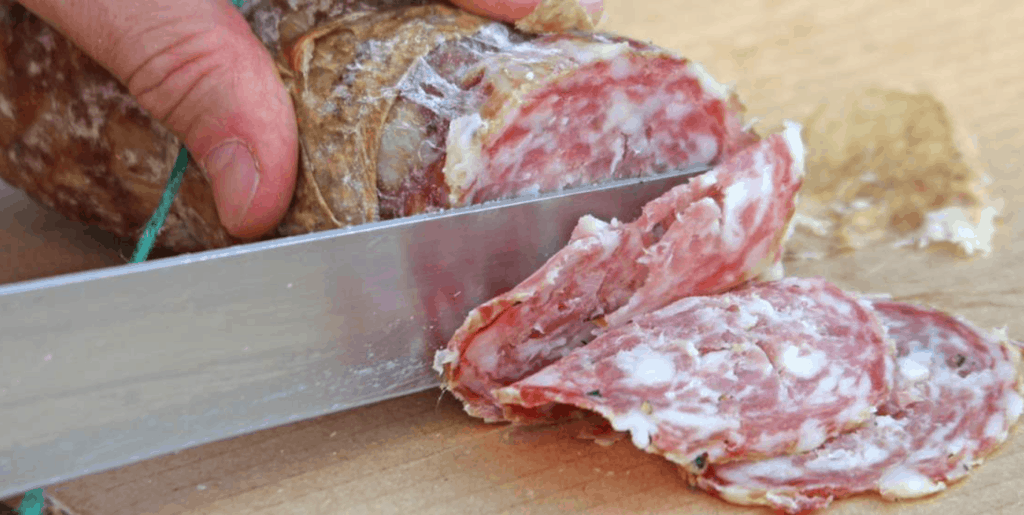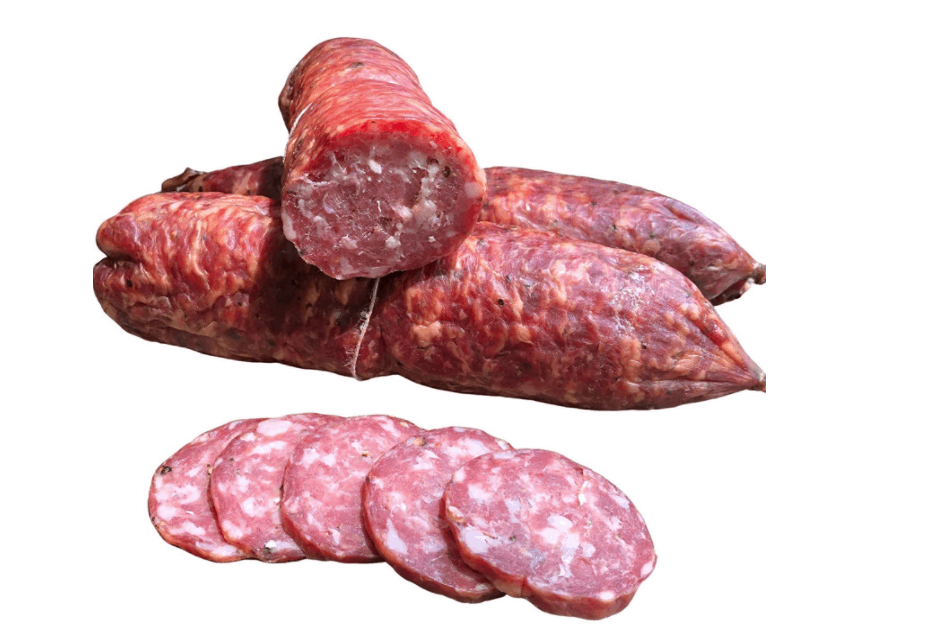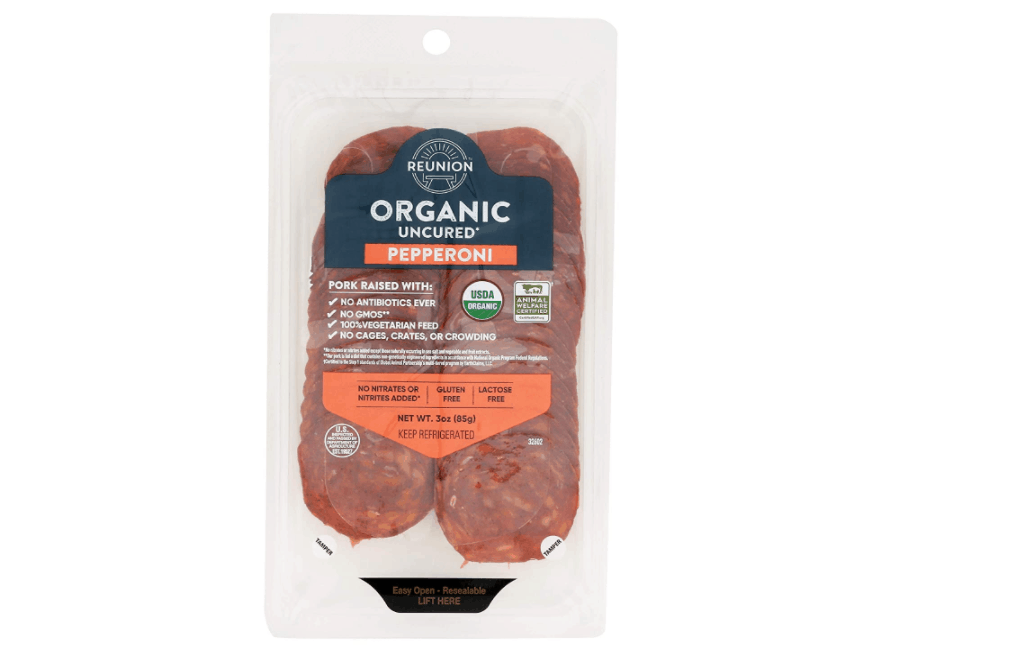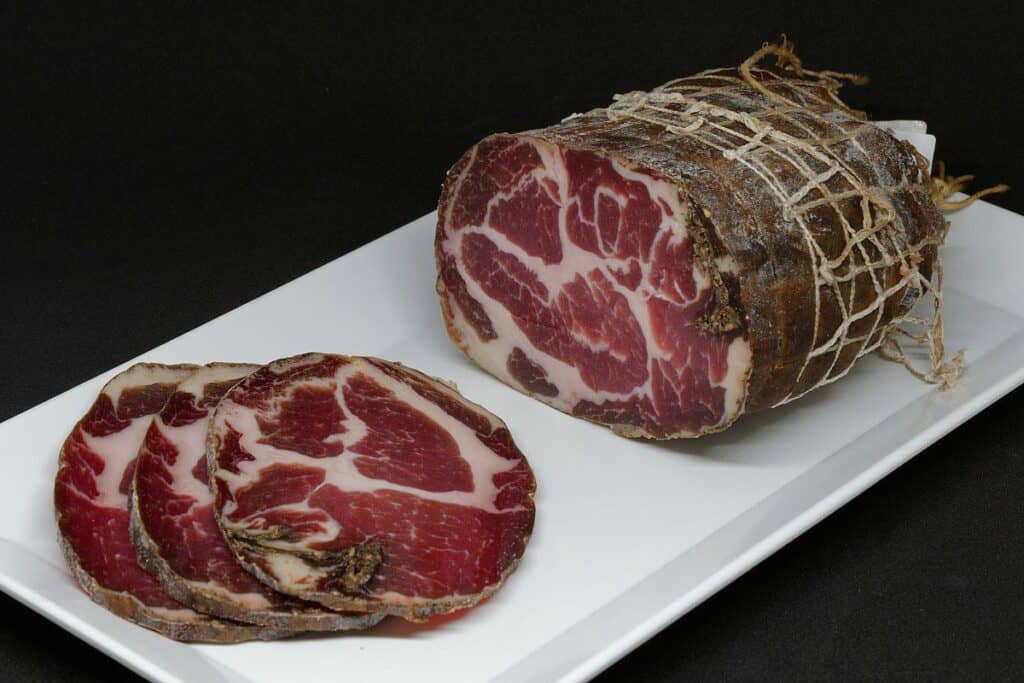- How to Find the Best Hand Meat Grinder - January 23, 2022
- How to Find the Best Jerky Making Kit - January 23, 2022
- How to Find the Best Sheep Casings for Meat - October 24, 2021
Soppressata and pepperoni are both types of cured dry sausage known as salami. For most people, simply mentioning pepperoni is enough to conjure up the image of a mouthwatering pizza pulled straight from the oven, oozing with melted cheese and little circular slices of delicious, smoky meat.
But what many people don’t know is that pepperoni is an American addition to what is otherwise a traditional Italian dish. Its Mediterranean cousin, soppressata, is equally as bold in flavor and, depending on which region of Italy it hails from, can vary considerably in taste.
Of course, pizza is not the only dish on which salami features. It is a versatile meat that can be cooked in several ways. There are so many unique varieties of salami – from Genoa and Cotto to even beef – that finding the right one for you can seem like a daunting task.
While pepperoni and soppressata share a number of similarities, it is crucial to also take note of their differences. In this Soppressata vs Pepperoni guide, we compare the two, taking into account both appearance and (most importantly!) taste, so you can select and savor your salami with satisfaction.
Main Differences Between Soppressata vs Pepperoni
The Main Differences Between Soppressata and Pepperoni are:
- First, pepperoni is deemed an Italian American creation, whereas soppressata originates from southern Italy.
- Pepperoni is often made with a mixture of pork and beef, whereas soppressata only use pork.
- Soppressata has a unique appearance amongst other salamis, with an oblong shape that hails from the technique used to prepare it, whereas pepperoni is circular.
- Traditional salami is hand-pressed, whereas soppressata is pressed between linen sheets with heavy stones on top.
- Soppressata is often seasoned with red wine, chili peppers, and peppercorns, whereas pepperoni is seasoned with salt, sugar, and spices like paprika.
- Soppressata of the Calabria region is strictly cut with a knife, whereas most other types of salami are cut using a food processor.
Soppressata – What You Need to Know
While soppressata is traditionally seen as a staple of southwest Italy, particularly the region of Calabria, there are many variations that exist throughout the country. Often, for southern Italian families, making soppressata is a way of life, and the skill of breeding pigs is passed down from one generation to the next. Consequently, this type of salami is as rich in history as it is in flavor.
In fact, it is possible to distinguish between soppressata from the north and from the south by taste; northern sopressa (known as Sopressa di Vincentina) is a variation characterized by its bold, aromatic flavor. Though soppressata’s taste is somewhat more subdued, it is still seasoned with a healthy dose of chili peppers, and some families also choose to add fennel seeds.
What on earth does soppressata look like?

This type of salami can be misleading, especially if you’re used to seeing around discs of pepperoni on top of your pizza! Soppressata is much more quirky with its unusual oblong shape.
Soppressata’s distinctive appearance makes it fairly easy to identify if you know what you’re looking for. Typically, the meat is less finely ground than in other types of salami, so its appearance is less smooth, and there are often larger chunks of fat visible.
So how does it taste?
Soppressata recipes are subject to personal taste; no two types of meat will be seasoned exactly the same, and that is what makes this type of salami so exciting and versatile. It can be sweet, salty, spicy, or smoky, depending on the chosen ingredients.
However, one thing is for certain: soppressata is always filled with a bold, mouthwatering flavor that provokes a satisfying sensation for your taste buds. Pair it with a glass of red wine for a heavenly combination.
How much does soppressata cost?

You can buy pre-sliced sopressata for as little as five dollars. If you’re looking for an unsliced version, a 14-16 ounce stick can be purchased for around twenty-five dollars, but it’s important to recognize that the price can fluctuate significantly depending on quality and authenticity.
For example, Calabrian soppressata is not readily available, though you can attempt the recipe at home. The cost of doing so will be dependent on the cut of meat you select. Ideally, this should be a shoulder cut, which can cost up to four dollars and even more, if you want organic, free-range meat.
If you decide to pursue the homemade route, our guide to the 32 best meat grinders of 2022 might come in handy!
How do you cook soppressata?
To create the correct quality and depth of flavor, it’s important to carefully follow each step of the process. If you succeed, you will have a wonderfully fresh, delicious treat to enjoy! The best part is that you can experiment and adapt the recipe to suit your unique taste.
Before we begin, let’s cover some important meat processing tools that will help you through the recipe. You’ll need a meat grinder, a sausage stuffer, and a meat curing chamber.
Making sopressata step-by-step:

- Using a 12mm plate, grind the meat and fat and refrigerate the mixture.
- Next, dissolve the Bactoferm culture in water. Then, combine with your chosen seasoning, for example, salt, garlic, pepper, and white wine.
- Pack your sausage into casings, tying both ends. Use a pin or something small and sharp to prick the casings – this will remove any air.
- The sausage now needs to rest at room temperature for around twelve hours, during which fermentation occurs.
- Finally, place the sausage into a curing chamber. The temperature should be 60°F with 60% humidity, and the process will take between 20 and 30 days.
Top Tip: Use kitchen scales to weigh your sausage before placing it in the curing chamber. When your soppressata is ready, its weight will have decreased by 30%.
Pepperoni – What You Need to Know
Like soppressata, pepperoni is a type of dried and cured sausage meat. Its name originates from the Italian word ‘peperoni’, meaning ‘bell pepper’ in English. While it might not typically be seen as the most interesting or fancy salami on the market, it’s actually a lot more versatile than you might think. Its distinctively juicy, piquant flavor means it can be used to spice up a huge number of dishes, from salads and nachos to pasta.
To find out more about pepperoni, including how to make your own flavorsome sausage, read on.
What does pepperoni look like?

Pepperoni is usually round, with vibrant red color and small pockets of fat clearly visible throughout – this is what makes it so delicious! When cooked in the oven at high temperatures, particularly when it has been thickly sliced, it tends to curl a little at the edges.
How does it taste, though?
One of the key differences between soppressata and pepperoni is that the latter type of salami is less spicy and often much softer in texture. The meat is flavored with plenty of salt, paprika, and lactic acid during the curing process, producing a distinctly tangy flavor that couples perfectly with the mild and creamy mozzarella cheese on top of most pizzas.
Other common types of seasoning include garlic powder and, surprisingly, sugar. But, whatever the combination of bold and wonderful spices – and they do vary from one recipe to the next – it’s certain that pepperoni has won a place in the hearts of most Americans, with millions of pounds being consumed each year.
How much will pepperoni set me back?

Like good quality meat without the hefty price tag? Then you’re in luck! Sliced pepperoni usually costs between $5-10 per pack, but the price can be influenced by a number of factors, including whether or not the meat is organic, how it has been prepared (for example, does it contain nitrites), and the conditions in which the animals were kept.
Alternatively, if you prefer to slice your own pepperoni, you can purchase sticks of it for roughly $10-20. Many people prefer to purchase pepperoni sticks because they have a more authentic appearance, but there’s no reason to think that these are of higher quality; pre-sliced pepperoni will look and taste just as sophisticated on a charcuterie board as its slightly less processed counterpart.
How do I cook pepperoni?
If you buy pepperoni from a store or online, it won’t need to be cooked. Instead, simply slice it up and toss it into your favorite dishes for an extra kick of flavor. However, if you want to make your own pepperoni, this can be a fun and fulfilling task too. Read on to find out how!
While the preparation time is only around sixty minutes for this recipe, you’re in for the long haul when it comes to curing, which takes over a thousand hours. However, this shouldn’t deter you from persevering because making pepperoni is still low-effort and high reward after the wait. Just think about how much you will savor those first few mouthfuls of smoky goodness…
So, let’s get started.
- Grind 7 pounds of pork and 3 pounds of lean beef using the coarse disk in your grinder.
- Add to this mix cayenne, paprika, garlic, ascorbic acid, salt, and sugar. Just like soppressata, you can season according to your own taste.
- Spread the mixture out on a large tray, cover, and cure in the fridge for 24 hours.
- Next, it’s time to prepare the casing. Rinse roughly four feet of sausage casing under cold water to remove any unwanted salt.
- Let the casing soak in a bowl of cool water for a half hour before flushing the inside out as well. To do this, place the end of the casing over the nozzle of the faucet and gently run the water.
- Return to the bowl of water, adding white vinegar to soften it.
- When you’re ready to stuff your meat into the casing, remove it from the water and vinegar mixture and wash thoroughly.
- After this, stuff the sausage meat inside the casing. You’re going to want roughly 10-inch links.
- Tie two separate knots of twine between links. Using scissors, snip between the double knots.
- Tie each pair together and then hang to dry. You’ll need very specific conditions to do this correctly: 50-55°F with 70-80% humidity. It will take approximately 6-8 weeks until your pepperoni is ready. The good news is that now you can relax! While you kick your feet back, why not take a look at our Ultimate Guide to Meat Seasoning and Spices?
I don’t think either of these sausages is for me. Are there any alternatives?

You’re in luck! There are probably hundreds of variations of sausage out there for you to try. Look hard enough, and you’re sure to find the right one for you. Fortunately, we’re also here to give a helping hand. So here are a few alternatives.
If you’re looking for an Italian-style cold cut meat…
- Capicola is a milder, more subtle option. These pork neck and shoulder roasts are seasoned with just a hint of pepper.
- Choose pancetta if you love the saltiness of bacon but want to avoid smoky flavors.
- If your diet doesn’t allow pork, check out our guide to beef salami to see if this is the right option for you.
If you want to explore cold cuts from other parts of the world…
- Chorizo is a Spanish sausage made from similar ingredients to pepperoni and sopressata. Many would claim its incredible flavor is unrivaled!
- Hailing from Germany, paprika lyoner is a fine textured pork meat with red and green capsicum.
Frequently Asked Questions
Question: Can you freeze soppressata and pepperoni?
Answer: There’s generally no need to freeze cured meats; the way they’re prepared means they last a long time anyway. All you need to do is keep them stored in the refrigerator. However, if you’re thinking about long-term storage, freezing is absolutely fine. The quality and taste of your meat will not be affected.
Question: Is pepperoni bad for you?
Answer: There is no straightforward yes or no answer to this question. It entirely depends on the amount you eat and how often you eat it. Cured meats are sometimes criticized for their high salt and fat content, so it’s important to only consume them in moderation. This is one area where sopressata comes out on top; its salt content is much lower. However, both types of meat are delicious when enjoyed as part of a balanced diet.
Question: Where can I buy pepperoni and sopressata?
Answer: Many butchers will stock cured meats, as well as raw and cold cuts, which are readily available in almost all supermarkets. One of the easiest ways to get hold of the specific type of salami you want is to search on Amazon, where you can access a huge selection, including those that are ethical and organic.
Question: Can I smoke soppressata?
Answer: Absolutely. This optional step occurs after the salami has been cured and allows you to alter the taste of the meat according to your preference.
Question: What can I use pepperoni and soppressata for apart from pizza toppings?
Answer: The list is almost endless!
– For a sophisticated meal, add these cold cuts to a charcuterie board with a smoky bottle of red wine and a delicious selection of cheeses.
– Cut them up and add them to salads for an extra kick of flavor.
– Layer into your favorite sandwiches.
Soppressata vs Pepperoni – Which one is best?
As we’ve established, the differences between pepperoni and soppressata are subtle, so it’s up to you to work out which flavors you relish the most. As for us? It’s certainly a tough one, but at the end of the day, soppressata just about wins for its diverse range of flavors and the rich history it represents.
Which one do you prefer? We’d love to hear from you in the comments!

